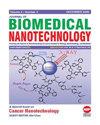三七皂苷通过抑制ET-1/PKC/TGF-β1信号通路减轻高糖诱导的肾小球内皮细胞损伤
IF 2.9
4区 医学
Q1 Medicine
引用次数: 0
摘要
本研究旨在探讨三七皂苷(PNS)对高糖诱导的肾小球内皮细胞(GEC)损伤的保护作用及其机制。采用高糖单独治疗、PNS单独治疗或PNS联合过度表达内皮素-1 (ET-1)治疗gec, ET-1是内皮功能障碍的关键调节因子。结果表明,高糖抑制细胞活力,增加活性氧(ROS)水平,上调纤维连接蛋白(FN)、IV型胶原(Col-IV)、蛋白激酶C (PKC)、转化生长因子- β 1 (TGF- β 1)和ET-1的表达。此外,高糖降低了抗氧化酶超氧化物歧化酶(SOD)、谷胱甘肽过氧化物酶(GSH-Px)和过氧化氢酶(CAT)的表达。PNS处理通过促进细胞活力,减少ROS生成,下调FN、Col-IV、PKC、TGF- β 1和ET-1表达,上调SOD、GSH-Px和CAT表达,显著保护高糖诱导的GEC损伤。然而,ET-1过表达逆转了PNS的保护作用,表明ET-1/蛋白激酶C (PKC)/TGF- β 1通路参与了PNS的保护作用。综上所述,PNS通过抑制ET-1/PKC/TGF- β 1通路,对高糖诱导的GEC损伤具有保护作用。这些发现提示PNS可能通过拮抗ET-1成为糖尿病肾病的潜在治疗靶点。本文章由计算机程序翻译,如有差异,请以英文原文为准。
Panax Notoginseng Saponins Alleviate High Glucose-Induced Glomerular Endothelial Cell Injury by Inhibiting the ET-1/PKC/TGF-β1 Signaling Pathway
This study aimed to investigate the protective effects and underlying mechanisms of Panax notoginseng saponins (PNS) on glomerular endothelial cell (GEC) injury induced by high glucose, which is crucial in the development of diabetic nephropathy. GECs were treated with high glucose alone, PNS alone, or a combination of PNS and overexpression of endothelin-1 (ET-1), a key regulator in endothelial dysfunction. The results showed that high glucose inhibited cell viability, increased reactive oxygen species (ROS) levels, and upregulated the expression of fibronectin (FN), collagen type IV (Col-IV), protein kinase C (PKC), transforming growth factor-beta 1 (TGF- β 1), and ET-1. Additionally, high glucose downregulated the expression of antioxidant enzymes superoxide dismutase (SOD), glutathione peroxidase (GSH-Px), and catalase (CAT). PNS treatment significantly protected against high glucose-induced GEC injury by promoting cell viability, reducing ROS generation, downregulating FN, Col-IV, PKC, TGF- β 1, and ET-1 expression, and upregulating SOD, GSH-Px, and CAT expression. However, ET-1 overexpression reversed the protective effects of PNS, indicating the involvement of the ET-1/protein kinase C (PKC)/TGF- β 1 pathway. In conclusion, PNS demonstrated a protective effect against high glucose-induced GEC injury by inhibiting the ET-1/PKC/TGF- β 1 pathway. These findings suggest that PNS may be a potential therapeutic target for diabetic nephropathy by antagonizing ET-1.
求助全文
通过发布文献求助,成功后即可免费获取论文全文。
去求助
来源期刊
CiteScore
4.30
自引率
17.20%
发文量
145
审稿时长
2.3 months
期刊介绍:
Information not localized

 求助内容:
求助内容: 应助结果提醒方式:
应助结果提醒方式:


